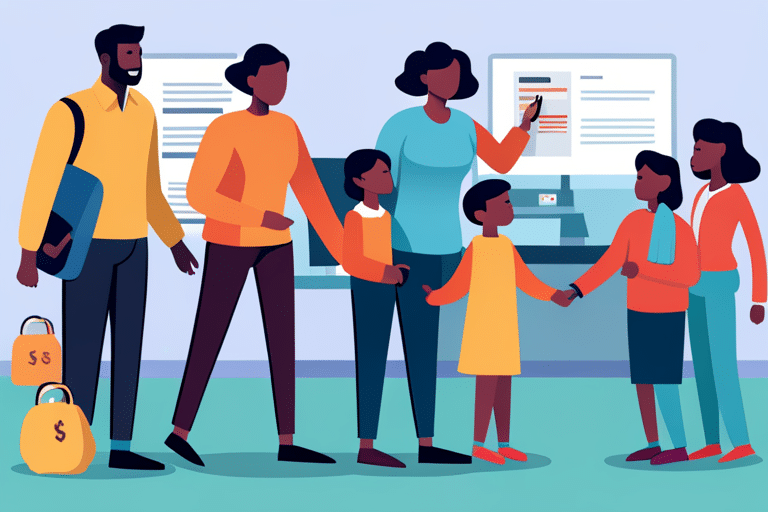Welcome to the world of federal student loans, where understanding the different types can feel as challenging as climbing Mount Everest with a backpack full of textbooks! But fear not, brave scholar.
This article is here to demystify the jargon and break down each loan type in a way that will make your head spin (in a good way). From Direct Subsidized Loans to Parent PLUS Loans, we’ve got you covered.
So grab a cup of coffee, put on your thinking cap, and let’s dive into this educational adventure together!
Key Takeaways
- Direct Subsidized Loans offer an interest subsidy while in school and the government pays interest during grace periods and deferment.
- Direct Unsubsidized Loans do not offer an interest subsidy and have different repayment options compared to Direct Subsidized Loans.
- Repayment options and strategies for federal student loans include income-driven repayment plans, loan consolidation, refinancing, and various repayment plans such as standard, graduated, and extended plans.
- Parent PLUS Loans have specific eligibility criteria and credit checks, and repayment options include graduated and extended plans. It is important to understand the responsibilities associated with Parent PLUS Loans.
Types of Federal Student Loans

You should familiarize yourself with the different types of federal student loans. Trust me, it’ll save you from a world of confusion later on. So, let’s dive into the sea of loan options together, shall we?
First up, we have Direct Subsidized Loans. These little beauties come with a built-in interest subsidy while you’re in school. It’s like having your own personal money-saving fairy godmother.
Next on our list are Direct Unsubsidized Loans. They don’t offer the same interest rate magic as their subsidized siblings, but hey, they’re still pretty handy when it comes to financing your education.
Now, let’s talk about PLUS Loans. These bad boys are for graduate students and parents who want to help finance their child’s education. Just be prepared for slightly higher interest rates.
If you’re feeling overwhelmed by multiple loans, fear not! There are consolidation options available that allow you to combine all your federal student loans into one manageable monthly payment.
Direct Subsidized Loans

Direct Subsidized Loans are like the superhero of federal student loans, swooping in to save the day and offer financial assistance to deserving students. These loans have a special power that sets them apart from other types: the government pays the interest on your loan while you’re in school, during grace periods, and even deferment. It’s like having a magical money fairy who takes care of those pesky interest charges for you.
But here’s the catch – this enchanting feature is only available to undergraduate students with demonstrated financial need. So, it’s important to check if you meet the eligibility requirements before summoning your hopes too high.
Now that we’ve covered Direct Subsidized Loans, let’s move on to their not-so-magical counterpart: Direct Unsubsidized Loans.
Direct Unsubsidized Loans

So, you’ve made it this far in your quest for student loans. Congrats! Now, let’s dive into the nitty-gritty details of Direct Unsubsidized Loans.
First things first, we need to talk about interest rates. Don’t worry, it’s not as scary as it sounds – we’ll break it down for you.
Next up, repayment options. You’ve got a few choices here, so let’s figure out which one fits your budget and lifestyle best.
And finally, qualification requirements and eligibility. Let’s uncover the secrets to unlocking this loan treasure chest together!
Interest Rates Explained
When considering federal student loans, it’s important to understand how interest rates work. Think of interest rates as the sneaky little creatures that can either make your loan repayment a breeze or turn it into a never-ending nightmare. So, let’s dive in and talk about these rates, shall we?
Now, different types of federal student loans have different interest rates. You might be wondering, ‘Well, what’s the difference between them?’ Great question! Direct Subsidized Loans generally have lower interest rates compared to Direct Unsubsidized Loans. And why does this matter? Because the higher the interest rate on your loan, the more you’ll end up paying back over time.
Repayment Options Available
Now that you’ve grasped the impact of interest rates, let’s explore the repayment options available for your federal student loans. Ah, the joys of paying back those loans. But fear not, my friend! Uncle Sam has got your back with a few nifty options.
First up, we have income-driven repayment plans. These bad boys take into account your income and family size to calculate a monthly payment that won’t break the bank. Plus, if you’re drowning in debt and still haven’t found a dream job (we feel ya), these plans can forgive any remaining balance after a certain number of years.
Next on the list is loan consolidation. It’s like combining all your student loans into one big happy family. With this option, you’ll only have to make one payment each month instead of juggling multiple due dates like a professional circus performer.
Qualification Requirements and Eligibility
To qualify for income-driven repayment plans or loan consolidation, you must meet certain eligibility requirements. But don’t worry, it’s not as complicated as deciphering hieroglyphics! Let’s break it down for you, oh wise and eager student.
First up, let’s talk about income-based repayment plans. These magical plans are designed to make your monthly payments more manageable by basing them on your income and family size. So, if you’re a struggling artist or a broke graduate just starting out in the real world, this could be music to your ears.
Now onto loan consolidation. Imagine having all your loans bundled up into one tidy package like a bouquet of flowers. Loan consolidation does just that! It combines all your federal student loans into one loan with a fixed interest rate and single monthly payment. It’s like the superhero of financial management!
But hold on tight, my friend! Before diving headfirst into these options, make sure you meet the eligibility criteria set by our friendly loan gurus. They may ask for proof of income or other documents to verify your qualifications.
Parent PLUS Loans

So, you’re a parent and your little one is all grown up and ready for college. Well, get ready because it’s time to dive into the world of Parent PLUS Loans!
First things first, let’s talk eligibility criteria. To qualify, you gotta be the biological or adoptive parent of an undergraduate student enrolled at least half-time. Oh, and don’t forget about those credit checks – no delinquencies or defaults allowed!
Now, onto repayment options. You’ve got a few choices here: standard repayment (paying off the loan in 10 years), graduated repayment (starting with lower payments that increase over time), or extended repayment (stretching out those payments for up to 25 years).
Time to crunch some numbers and figure out which option works best for you!
Eligibility Criteria for Parent PLUS Loans
Parent PLUS loans have specific eligibility criteria that parents must meet in order to qualify. But fear not, dear parent! It’s not as daunting as it sounds.
To begin the application process, you’ll need to complete the Free Application for Federal Student Aid (FAFSA). Once that’s done, you’ll need to pass a credit check (don’t worry too much about this – they’re just making sure you don’t have any serious credit issues).
And here’s the kicker: unlike other federal student loans, there are no income requirements for Parent PLUS loans. So even if you’re bringing home bacon or tofu dogs by the truckload, you can still apply!
Now that you know how to qualify for a Parent PLUS loan, let’s dive into the exciting world of repayment options!
Repayment Options for Parent PLUS Loans
The repayment options for Parent PLUS loans can provide flexibility and relief for parents. So, you’ve taken on the role of a superhero parent, saving the day by helping your child get through college. Now it’s time to tackle those loan repayments like a pro! Here are some options to consider:
-
Income Driven Plans: These plans adjust your monthly payments based on your income and family size. They can be a great way to manage your repayment while still having money left over for all those fancy vacations you deserve.
-
Loan Consolidation: This option allows you to combine multiple federal loans into one, making it easier to keep track of payments and potentially lowering your interest rate. It’s like Marie Kondo-ing your loan situation!
-
Flexible Repayment Terms: Depending on the plan you choose, you may have the option to extend your repayment timeline or make smaller payments at first and gradually increase them over time. It’s all about finding what works best for you!
Grad PLUS Loans

Hey, you, future master of your domain! Did you know that Grad PLUS loans are available to grad and professional students like yourself? These loans can be a lifesaver when it comes to covering the cost of your education.
But before you jump on the loan bandwagon, let’s talk about interest rates. The good news is that Grad PLUS loans have fixed interest rates, which means they won’t fluctuate over time. This stability can give you peace of mind as you plan your financial future.
Now, let’s dive into the pros and cons. On one hand, these loans offer flexible repayment options and can help bridge the gap between scholarships and other financial aid. On the other hand, they do come with higher interest rates compared to other federal student loans.
So weigh your options carefully and make sure to crunch those numbers before making any decisions.
Good luck on your journey towards mastery!
Perkins Loans

Perkins loans have lower interest rates compared to other federal student loans, making them an attractive option for students in need of financial assistance.
So, let’s dive into the wonderful world of Perkins loans and see if they’re the right fit for you!
Here are three things you need to know about Perkins loans:
-
Eligibility: To qualify for a Perkins loan, you must demonstrate exceptional financial need. It’s like trying to find that rare Pokémon card – not everyone can get it, but if you meet the requirements, it’s a real game-changer.
-
Interest Rates: Unlike your crazy aunt who charges outrageous interest on borrowed money, Perkins loans offer low fixed interest rates. Your wallet will thank you later when those monthly payments don’t drain your bank account faster than a thirsty vampire.
-
Repayment Options: With Perkins loans, you have some flexibility in repayment plans. You can choose from standard or income-driven options. It’s like having different flavors of ice cream – pick the one that suits your taste and budget.
Federal Work-Study Program

Interested in earning money while gaining valuable work experience? The Federal Work-Study Program might just be the perfect opportunity for you! Picture this: you’re a student, drowning in textbooks and coffee, trying to make ends meet. Well, fear not my friend, because with the federal work-study program, you can earn some extra cash and gain job experience at the same time. It’s like killing two birds with one stone (although we don’t really advocate bird murder). So how does it work? Take a look at this handy-dandy table below:
| Job Opportunities | Hourly Wage | Flexible Schedule |
|---|---|---|
| Library Assistant | $10 | Yes |
| Tutoring | $12 | Yes |
| Campus Event Staff | $11 | Yes |
| Office Assistant | $12 | Yes |
| Research Assistant | $13 | Depends on project |
See? There are various job opportunities available through the program that cater to different interests and skills. Plus, with flexible schedules, you can juggle your classes while still making some moolah. So why not give it a shot? Earn money and gain experience – sounds like a win-win situation to me!
Loan Forgiveness Programs

Loan forgiveness programs provide a way for individuals to have their student loans forgiven or canceled under certain conditions. It’s like finding the golden ticket in Willy Wonka’s chocolate factory, except instead of candy, you get freedom from debt! So, let’s dive into this sweet deal and explore what loan forgiveness programs have to offer:
- Public Service Loan Forgiveness: Work in a qualifying public service job for 10 years and poof! Your loans disappear!
- Teacher Loan Forgiveness: Teach at a low-income school for five years and watch as your loans wave goodbye.
- Income-Driven Repayment Plans: Make affordable monthly payments based on your income, and after 20 or 25 years of faithful payments, the remaining balance is forgiven.
Now that we’ve indulged in the world of loan forgiveness programs, let’s take a detour to explore repayment options and strategies to help you navigate the post-college financial maze.
Repayment Options and Strategies

Alright, now that you’re all caught up on those enticing loan forgiveness programs, let’s dive into the world of repayment options and strategies. Trust me, I know this topic might make you want to crawl under a rock, but fear not! We’re here to break it down for you in a fun and lighthearted way.
First things first, have you ever heard of loan consolidation? It’s like taking all your student loans and throwing them into a magical blender. Poof! They become one big loan with one monthly payment. It’s like decluttering your financial life. Plus, it can potentially lower your interest rate and simplify your repayment process.
Now, let’s talk about income-driven repayment plans. These are like personalized repayment plans tailored just for you based on how much money you make. So instead of drowning in high monthly payments, these plans adjust according to your income level. It’s like having a genie granting your financial wishes!
Frequently Asked Questions
How Can I Qualify for a Federal Student Loan?
To qualify for a federal student loan, you need to meet the qualifying criteria and go through the application process. It may sound complicated, but don’t worry! We’ll guide you through it with ease. You got this!
Can I Use Federal Student Loans to Pay for Graduate School?
Yes, you can use federal student loans to pay for graduate school! They provide funding options specifically designed for grad students like you. Explore the different types available and start your educational journey!
What Is the Interest Rate on Federal Student Loans?
What are the current interest rates on federal student loans? Well, my friend, let me break it down for you. The interest rates vary depending on the type of loan, but they’re generally pretty reasonable. Don’t worry, you got this!
Can I Consolidate My Federal Student Loans?
Sure! Consolidating your federal student loans has many benefits. It simplifies repayment by combining multiple loans into one, potentially lowers your monthly payments, and gives you the opportunity to choose a new repayment plan. The consolidation process is easy and can be done online.
Are Federal Student Loans Forgiven After a Certain Number of Years?
Yes, federal student loans can be forgiven after a certain number of years. It’s like finding a golden ticket! Through income-driven repayment plans and federal student loan forgiveness programs, you can have your loans wiped away. Isn’t that magical?
Conclusion
So now you’re all clued in on the different types of federal student loans. Isn’t it exciting? The suspense was killing you, I know.
But hey, knowledge is power, right? Now that you understand the ins and outs of these loans, you can navigate the crazy world of student debt with a little more confidence.
Remember, there are repayment options and loan forgiveness programs out there to help ease your burden. So keep your head up and march forward into the wild world of adulthood!
Good luck!

